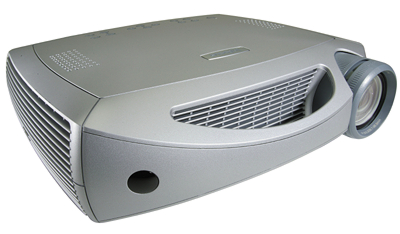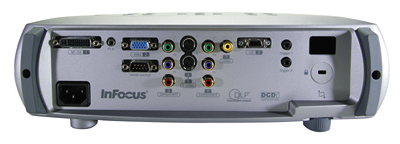The InFocus Screenplay 7200 is a front or rear projector that can be installed on the ceiling or put on a tabletop and utilized quickly and easily. The InFocus projector can project 1000 ANSI lumens of brightness, has a 1400:1 contrast ratio, and can show 16.7 million colors phrazle at the same time. The Faroudja DCDi FLI2300 processing chip powers the DLP projector, enabling for noise reduction, color and sharpness improvement, and scaling.
InFocus ScreenPlay 7200 DLP projector

The new InFocus ScreenPlay 7200 changes all that. It lowers the price of an HD2 projector below $10,000. Does it deliver the same level of high-definition quality as more expensive HD2 models? That's the $2000 question.
InSide the InFocus
Along with TI's HD2 chip, InFocus stuffs a number of well-respected image-enhancing technologies into the ScreenPlay 7200. Faroudja's DCDi FLI2300 picture-processing chipset handles the deinterlacing and supplies additional color, sharpness, and noise-reducing circuitry. A six-segment, 5x color wheel operating at 9000rpm promises to minimize rainbow effects. Carl Zeiss, the world-renowned lens manufacturer, supplies the ScreenPlay 7200's custom-designed optics.
Unlike many projectors, the ScreenPlay 7200 uses 6500 kelvins as its default color temperature (other temperatures are available). Its ultra-high-pressure (UHP) lamp can be operated at 200W or 250W. According to InFocus, the 250W setting provides "the industry's brightest image": 1000 ANSI lumens. If you plan to use the InFocus to produce an especially large image in a good-sized room, the higher lamp output could prove invaluable. The 7200's published specifications are mighty impressive, especially its "filmlike" contrast ratio of 1400:1. Yessiree—on paper, the ScreenPlay 7200 looks like a world-beater.
OutSide the InFocus
The eight selectable inputs on the ScreenPlay 7200's rear panel should accommodate every possible source, including two three-connector component video, two S-video, and DVI with HDCP. There are also 3.5mm minijacks for an IR repeater, a 12V trigger input, and a 12V trigger output.
Since InFocus opted for an M1-DA plug instead of a plain-vanilla DVI connector for sources with DVI output, you must purchase a cable with a standard DVI connector on one end and the M1-DA connector on the other. If you have only a regular DVI cable, you're downstream without a paddle—InFocus offers no adapters. They do make two lengths of adaptor cable available: 6 feet and 30 meters. If your setup requires a longer run, Kayye Consulting makes a range of cables, from 20 meters ($760) to 50 meters ($1270), available from www.dvigear.com. For such long runs, Kayye also recommends a DVI repeater to maintain optimum resolution. That's another $399. Ouch.
InFocus offers a projector mount with a false ceiling plate and 26–47-inch extension arm. Using these accessories, installing the 9.1-pound ScreenPlay on a ceiling should be a snap in almost any room. Virtually no light spills from the 7200's case, but the lens's prodigious light output means that the accessory extension arm might be necessary to position the projector away from the ceiling in order to prevent too much light from bouncing off the ceiling and onto your screen. Using light-absorbent ceiling tiles and painting the area around the projector flat black will also help reduce light bounce.
Along with a complete set of keypad controls on the top of the projector, the ScreenPlay 7200 comes with a small, oval remote control that fits comfortably in the hand and features a side button that lights up all of its buttons for about 10 seconds. The remote's layout is well-designed, logical, and intuitive; after only a few days, I no longer needed to light up the buttons to find the one I wanted. The 7200's hierarchical menu system requires quite a bit of button-pushing during initial setup, but the remote's shortcut buttons for aspect ratio, overscan, contrast, and brightness streamline on-the-fly adjustments. The IR sensor is located on the projector's front, and it's sensitive enough to easily receive signals bounced off a screen or front wall.

The main menu offers four selections: Picture, Settings, About, and Exit. The Settings menu controls such particulars as startup logo, blank-screen language, Service, and System. Within the System submenu you can specify mounting location, auto power, message display, lamp power level, chimes, translucent onscreen display, and the power-save option. The Service submenu includes a Reset switch to return all settings to their factory defaults, internal test patterns, and the option to enter a code so authorized servicefolk can perform in-field adjustments. The About menu informs the user of the number of hours the lamp has been used, the active source, the current signal format, and the software version installed.
Adjustable via the Picture menu are electronic keystone, contrast, brightness, color intensity, tint, aspect ratio, presets, and Advanced controls: chroma and luma detail, color space and temperature, gamma, video standards, overscan, phase, tracking, horizontal and vertical position, TrueLife color, and NTSC 3:2 (film) and 2:2 (computer) pulldown. The Color Control submenu lets you change the red, green, and blue gain and offset. This level of color control, usually unavailable to end-users, makes it possible to fine-tune or royally screw up the ScreenPlay's color balance. But when used judiciously, the projector's picture controls permit the projector to deliver optimal images regardless of source or environment.
Like other HD2-based DLP projectors, the ScreenPlay 7200 is designed for 16:9 screens. Its five aspect-ratio options are 16:9, 4:3, Native, Letterbox, and Natural Wide. The 4:3 ratio displays NTSC TV images in the projector's 16:9 projected space with black bands on either side. If you want to fill your 16:9 screen with a 4:3 picture, you have two options: Letterbox blows up 4:3 images, lopping off the top and bottom so the remainder of the image fills a 16:9 space, while Natural Wide stretches a 4:3 image to fit a 16:9 screen. Don't even think about watching the "full-screen" version of Shallow Hal in Natural Wide. Finally, for those of us who like our images straight, with no electronic frame reshaping, the Native mode bypasses the internal scaler, producing a smaller but properly full-frame 4:3 or 16:9 image.
- Log in or register to post comments


While the contrast produced by the 7200 was adequate on my Stewart FireHawk screen, it was not as good as what the other HD2 geometry dash lite projectors we've seen. I like this feature of the device. Actually, each other parameter will have a clearly different sound quality.




































































